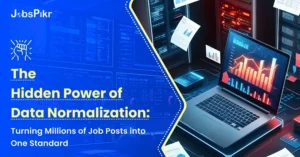In today’s competitive recruitment landscape, finding the right talent at the right time is crucial for companies and recruitment agencies. To stay ahead, agencies must constantly refine their talent sourcing strategy, making use of new technologies and tools that provide real-time insights into the candidate market. One powerful tool in this process is job data feeds, which offer up-to-the-minute information about potential candidates, helping agencies and companies to optimize their sourcing efforts.
This article explores how recruitment agencies can leverage job data feeds to enhance their talent sourcing practices, stay competitive, and meet client needs more efficiently. We will also look at how this approach fits into a broader talent acquisition sourcing strategy and how it provides an edge in today’s fast-paced hiring environment.
What is Talent Sourcing?
Talent sourcing refers to the proactive search for qualified candidates to fill current or future job vacancies. Unlike traditional recruitment, which often waits for candidates to apply, talent sourcing focuses on finding and engaging potential hires before they are even looking for a new job. This makes the process more strategic and allows companies to build a pool of talent that can be tapped into when needed.
Given the rising competition for top talent, having an effective talent sourcing strategy is more important than ever. It enables companies and agencies to avoid the reactive scramble when a position opens and ensures that they are continuously identifying high-quality candidates.
How Job Data Feeds Revolutionize Talent Sourcing Strategies?
One of the biggest challenges in talent sourcing is staying on top of the rapidly changing job market. Candidates today are more mobile, and their profiles and availability can shift quickly. To remain competitive, recruiters need real-time data about the candidate landscape, which is where job data feeds come into play.
Job data feeds are essentially streams of structured data that provide continuous updates about job candidates, open positions, and the overall job market. These feeds aggregate information from various online sources, including job boards, social media platforms, and career websites, giving recruiters access to a broader and more accurate view of the candidate pool.
Here’s how job data feeds can improve your talent sourcing strategy…
1. Access to Real-Time Candidate Insights
Traditional sourcing methods often rely on outdated candidate databases, which can limit the recruiter’s ability to find fresh talent. Job data feeds, on the other hand, provide real-time updates about candidates’ career moves, skill developments, and availability. This real-time access means you can identify candidates who are actively looking for new opportunities or those who may not be publicly listed but are open to being approached.
For instance, you can track when someone updates their LinkedIn profile or completes a new certification. This immediate insight allows recruiters to act faster, giving them a competitive advantage over agencies that rely on outdated data.
2. Broader Talent Pool
By using job data feeds, recruitment agencies can tap into a much larger talent pool. These feeds pull data from multiple sources, including niche job boards, industry-specific platforms, and social media networks, giving access to a broader range of candidates. This helps agencies diversify their talent acquisition sourcing strategy, ensuring they aren’t reliant on a single platform or database.
Additionally, job data feeds can help agencies source passive candidates—those who aren’t actively applying for jobs but could be persuaded to move for the right opportunity. These candidates are often highly sought after, and having access to up-to-date information about them is key to staying ahead in the recruitment game.
3. Improved Candidate Matching
An optimized talent sourcing strategy doesn’t just focus on finding candidates; it focuses on finding the right candidates. Job data feeds can help improve candidate matching by allowing recruiters to filter candidates based on specific skills, experiences, and career objectives. This precision ensures that the candidates identified are better suited for the roles you’re filling, reducing the time spent on screening unqualified applicants.
For example, if you’re looking for a data scientist with specific experience in AI or machine learning, a job data feed can help you quickly identify candidates who meet these exact criteria. This leads to a more efficient hiring process, as the candidates you engage with are more likely to be the right fit from the start.
How to Integrate Job Data Feeds into Your Talent Sourcing Strategy?
To fully leverage the power of job data feeds, it’s important to integrate them seamlessly into your talent sourcing strategy. This involves more than just subscribing to a data feed; it means using that data in a way that supports long-term recruitment goals and enhances your overall process.
1. Building a Dynamic Talent Sourcing Strategy Template
For recruitment agencies, a talent sourcing strategy template can serve as a roadmap for how to use job data feeds effectively. This template should outline how your agency plans to integrate real-time data into everyday sourcing activities and how it will use that data to engage with candidates.
Some key components of this template might include:
- Sourcing Channels: Identify the various channels (job boards, social media, industry platforms) you’ll use to pull data from.
- Data Utilization: Define how you will use the data from job data feeds to identify potential candidates, such as filtering by industry, skillset, or location.
- Engagement Tactics: Outline how your agency plans to engage candidates once they’ve been identified through data feeds. Will you reach out via LinkedIn, email, or phone? What messaging will you use?
- Performance Metrics: Track how effective your sourcing strategy is by measuring key metrics like time-to-fill, candidate quality, and response rates.
Having a solid talent sourcing strategy template in place helps ensure that your agency is using job data feeds in a structured and effective way.
2. Enhancing the Talent Sourcing Process
When integrating job data feeds into your process, it’s essential to understand what is the next step of the talent sourcing process after planning strategy? Once you’ve gathered real-time candidate data and developed a clear sourcing plan, the next step is to engage with candidates efficiently and meaningfully.
Job data allows you to take a more personalized approach to candidate outreach. Since you have access to up-to-date information about their skills, recent job changes, and career aspirations, you can tailor your messaging to resonate more effectively. This approach improves response rates and increases the likelihood of converting passive candidates into active job seekers.
3. Continuous Refinement of Your Talent Sourcing Strategy
Finally, to make the most of job data feeds, recruitment agencies should constantly review and refine their talent acquisition sourcing strategy. This involves regularly evaluating the quality of the candidates sourced through data feeds and adjusting your approach as necessary.
For example, if you find that certain data sources are consistently yielding high-quality candidates, you can increase your focus on those platforms. On the other hand, if certain channels are not providing strong results, it may be worth shifting your resources to other, more productive areas.
How Real-Time Data is Shaping the Future of Talent Sourcing?
As the recruitment landscape continues to evolve, the ability to access and act on real-time data will only become more important. Agencies that leverage job data feeds to enhance their talent sourcing strategy will have a distinct advantage over those that rely on traditional, outdated methods. By using data to identify, engage, and hire the best candidates, recruiters can offer faster, more efficient services to their clients.
Moreover, job data feeds can also help agencies predict hiring trends, allowing them to advise their clients on potential talent shortages or surpluses in certain industries or skill sets. This kind of insight is invaluable in a market where timing is everything.
Conclusion:
In today’s fast-paced job market, recruitment agencies need every advantage they can get to stay competitive. Incorporating job data feeds into a well-crafted talent sourcing strategy allows agencies to access real-time insights, engage with top talent more effectively, and ultimately, improve their time-to-hire and candidate quality.
By building a talent sourcing strategy template that integrates job data feeds and continuously refining that strategy, agencies can ensure they are always a step ahead of the competition. Whether you are sourcing for highly specialized roles or filling high-volume positions, using data to guide your efforts is the key to success in modern recruitment.
So, as you look to optimize your talent acquisition sourcing strategy, don’t overlook the power of job data feeds. In an industry where the best candidates often get snapped up quickly, having access to real-time information is essential for staying competitive and delivering results for your clients.
By staying on top of these trends and utilizing the right tools, recruitment agencies can not only meet their clients’ needs but also lead the way in the evolving landscape of talent sourcing. Sign-up with JobsPikr and explore the features to improve your business.




